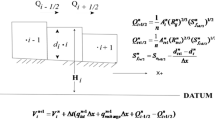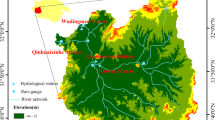Abstract
Urban inundation due to anomalous storms is a serious problem for many cities worldwide. Therefore, it is important to accurately simulate urban hydrological processes and efficiently predict the potential risks of urban floods for the improvement of drainage designs and implementation of emergency actions. However, the complexity of urban landforms and the diversity of hydraulic infrastructure pose particular challenges for the simulation and risk assessment of urban drainage processes. This study developed a methodology to comprehensively simulate inundation processes by dynamically coupling 1D and 2D hydrodynamic models. By allowing the simultaneous solution of the processes of rainfall and runoff, urban drainage, and flooding, this method can be used to estimate the potential inundation risks of any designed drainage system. Furthermore, a Geographical Information System (GIS) based platform was fully integrated with the model engine to effectively illustrate the context of the problem. The developed model was then demonstrated on the Beijing 2008 Olympic Village under the conditions of the 5-year and 50-year design storms. The sewer discharge, channel discharge, and flood propagation (inundation initiation, extent, depths, and duration) were numerically validated and analyzed. The results identified the potential inundation risks. From the study, it is found that the coupled GIS and 1D and 2D hydrodynamic models have the potential to simulate urban inundation processes, and hence efficiently predict flood risks and support cost-effective drainage design and management. It also implies promising prospects about the wide availability of high quality digital data, GIS techniques, and well-developed monitoring infrastructure to develop online urban inundation forecasts.
Similar content being viewed by others

References
Dunne T, Leopold L B. Water in Environmental Planning. San Francisco: W. H. Freeman Co., 1978
Mark O, Weesakul S, Apriumanekul C, et al. Potential and limitations of 1D of urban flooding. J Hydrol, 2004, 299: 284–299
Pei Y S, Zhao Y, Zhang J P. Trend and strategies for urban water resources development and utilization. Adv Sci Tech Water Resources, 2005, 25(4): 1–4
Zheng Z F, Fan S Y. Analysis of Severe Rainfall in Urban District of Beijin. Catastro, 2005, 20(2): 66–70
Mignot E, Paquier A, Haider S. Modelling floods in a dense urban area using 2D shallow water equations. J Hydrol, 2006, 327(1–2): 186–199
Niehoff D, Fritsch U, Bronstert A. Land-use impacts on storm-runoff generation: scenarios of land-use change and simulation of hydrological response in a meso-scale catchment in SW-Germany. J Hydrol, 2002, 267: 80–93
Campana N A, Tucci C E M. Predicting floods from urban development scenarios: Case study of the Diluvio Basin, Porto Alegre, Brazil. Urban Water, 2001, 3: 113–124
Zoppou C. Review of urban storm water models. Nat Hazards, 2001, 16(3): 195–231
Culshaw M G, Nathanail C P, Leeks G J. The role of web-based environmental information in urban planning-the environmental information system for planners. Sci Total Environ, 2005, 360(1–3): 233–245
Fang H W, Zheng Yi, Zhang B, et al. Decision-support system for flood control in Dagu River Basin in Qingdao. Adv Sci Techno Water Resour, 2008, 28(3): 66–69
Xie Z T, Zhang X F, Tan G M, et al. Study and application of mathematical model for one-dimensional flood-routing. Engin J Wuhan Univer, 2005, 38(1): 69–72
Dong C H, Wang B D. Study and application of one-dimensional model for river network with unsteady flow. Water Res Hydro Eng, 2005, 36(4): 19–20
Zhang X F, Mu J B, Yuan J. Real-time forecasting method based on 1 D unsteady channel flow. Hydrody, 2005, 20(3): 400–404
Zhang X H, Long W F, Xie H P, et al. Numerical Simulation of Flood Inundation Processes by 2D Shallow Water Equation. Sichuan Univer (Engineering Science Edition), 2006, 38(1): 20–25
Yen B C, Akan A O. Hydraulic Design of Urban Drainage Systems. In: Mays L W, ed. Hydraulic Design Handbook. New York: McGraw-Hill, 1999
Hromadka T V, Lai C. Solving the two-dimensional diffusion flow model. In: Proc. of the Spec. Conf., sponsored by the Hydr. Div. of ASCE. Florida: Lake Buena Vista, 1985. 12–17
Wasanthalai A M. Performance comparison of overland flow algorithms, J Hydrol Eng, 1998, 124(4): 342–349
Bates P, De Roo A P J. A simple raster-based model for flood inundation simulation. J Hydrol, 2000, 263(1–2): 54–77
Brown J D. Modeling storm surge flooding of an urban area with particular reference to modeling uncertainties: A case study of Canvey Island, United Kingdom, Water Resources Research, 2007, 43, doi: 10.1029/2005WR004597
Hsu M H, Lai J S, Yen C L. Two-dimensional inundation model for Taipei city. In: Proceedings of Fifth International Conference on Urban Storm Drainage. Japan: Osaka, 1990. 169–174
HR Wallingford Ltd. HydroWorks. User Manual. UK: Oxon, 1997
DHI. MIKE 11 — A Microcomputer Based Modelling System for Rivers and Channels, Technical Reference. Version 2008. Denmark: Danish Hydraulic Institute, 2008
Schmitt T G, Thomas M, Ettrich N. Analysis and modelling of flooding in urban drainage systems. J Hydrol, 2004, 299: 300–311
Rao N S L, Delleur J W, Sarma B S P. Conceptual hydrologic models for urbanizing basins. J Hydr Eng Divs, 1972: 120–1220
Marsik M, Waylen P. An application of the distributed hydrologic model CASC2D to a tropical montane watershed. J Hydrol, 2006: 330(3–4): 481–495
Boughton W, Droop O. Continuous simulation for design flood estimation — a review. Environ Modell Softw, 2003, 18: 309–318
Rui X F, Huang G R. The prospecting study on distributed hydrological models. Adv Sci Tech Water Resour, 2004, 24(2): 55–58
Zerger A, Wealands S. Beyond modeling: Linking models with GIS for flood risk management. Nat Hazards, 2004, 33: 191–208
Sui D Z, Maggio R C. Integrating GIS with hydrological modeling: practices, problems, and prospects. Computer, Environment and Urban Systems, 1999, 23(1): 33–51
Lei Y, Jiang D, Yang X H, et al. The Water Distribution Model Application Based on Spatial Information Technology. Geo-Inform Sci, 2007, 9(5): 64–69
Zhao H B, Zeng Z Y, Hu Y M. Review of the Technology of Distributed Physical Models System for Simulating Geographic Processes. Res Agri, 2006. 10: 37–42
Li D F, Liu Ch M. Runoff Simulation with Physical-Based Distributed Hydrological Model Based on RS and GIS. Soil Water Conser, 2004, 18(4): 12–15
Li F W, Zhang X N, Cheng D U. Study on flood submergence based on GIS and mathematical morphology. Advances in Science and Technology of Water Resources, 2005, 25(6): 14–16
Jain M K, Kothyari U C, Ranga Raju K G. A GIS based distributed rainfall-runoff model. J Hydrol, 2004, 299(1–2): 107–135
Knebl M R, Yang Z L, Hutchison K, et al. Regional scale flood modeling using NEXRAD rainfall, GIS, and HEC-HMS/RAS: A case study for the San Antonio River Basin Summer 2002 storm event. J Environ Manage, 2005, 75: 325–336
Abbott M, Ionescu F. On the numerical computation of nearly-horizontal flows. J Hydraul Res, 1967, 5: 97–117
Chow V T. Open-Channel Hydraulics. New York: McGraw-Hill, 1959
Beasley D B, Huggins L F. Answers: User’ Manual. EPA-905/9-82-001, Chicago: Environmental Protection Agency, 1982
Author information
Authors and Affiliations
Corresponding author
Additional information
Supported by the National Natural Science Foundation of China (Grant No. 40601018)
About this article
Cite this article
Li, W., Chen, Q. & Mao, J. Development of 1D and 2D coupled model to simulate urban inundation: An application to Beijing Olympic Village. Chin. Sci. Bull. 54, 1613–1621 (2009). https://doi.org/10.1007/s11434-009-0208-1
Received:
Accepted:
Published:
Issue Date:
DOI: https://doi.org/10.1007/s11434-009-0208-1



